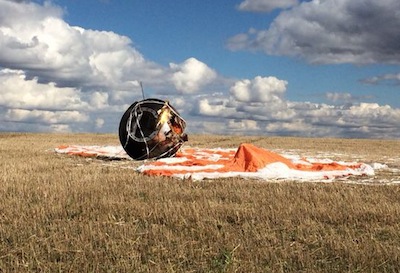Main » Entries archive
 Russian Soyuz TMA-12M undocked from ISS. Russian Soyuz TMA-12M undocked from ISS.
On September 10, 2014 at 23:01 UTC (on September 11, 2014 at 03:01 Moscow time) the Russian “Soyuz TMA-12M” spacecraft undocked from the Russian "Poisk” (MIM-2) module of the International Space Station to deliver to Earth the 3 members of Expedition 40 – Russian cosmonauts Aleksandr Skvortsov and Oleg Artemyev as well as American astronaut Steven Swanson.
|
 China launched remote sensing satellite. China launched remote sensing satellite.
On September 09, 2014 at 03:22 UTC the “Long March – 3B” (“Changzheng-3B”) rocket-carrier was launched from the Taiyuan Satellite Launch Center in north China's Shanxi Province. The rocket orbited the “Yaogan-21” remote sensing satellite. The rocket also orbited the “Tiantuo-2” satellite, designed and built by the National University of Defense Technology (NUDT). Yaogan-21 will be used for scientific experiments, natural resource survey, estimation of crop yield and disaster relief, while Tiantuo-1 was designed for smart satellite experiments.
Looking through: 1252 |
Date: 01.10.2014
| Rating: 0.0/0
|
 SpaceX launched AsiaSat. SpaceX launched AsiaSat.
On September 07, 2014 at 05:00 UTC the “Falcon-9” rocket-carrier was launched from Cape Canaveral launch site of US Air Force. The launch was performed by the SpaceX company. The rocket orbited the “AsiaSat-6” telecommunications satellite. AsiaSat is a commercial satellite operator based in Hong Kong. Manufactured by Space Systems/Loral of Palo Alto, Calif., USA, the “AsiaSat-6” was expected to raise its orbit to geosynchronous altitude within a few days, where it will hover over the equator for its 15-year mission.
Looking through: 1301 |
Date: 01.10.2014
| Rating: 0.0/0
|
 CubeSat satellites launched from Space Station. CubeSat satellites launched from Space Station.
On September 05, 2014 at 09:29 UTC the “Flock-1b.17” and “Flock-1b.18” CubeSat satellites were launched from the International Space Station. CubeSat satellites were deployed from the Japanese “Kibo” module of the ISS.
|
 China launched two satellites. China launched two satellites.
On September 04, 2014 at 00:15 UTC the “Long March – 2D” (“Changzheng-2d”) rocket-carrier was launched from the Jiuquan Satellite Launch Center in Jiuquan, Gansu Province, the northwest of China. The rocket orbited 2 telecommunications satellites. One of the satellites is the Chuangxin-1-04, which is designed to collect and transmit data on hydrology, weather, electric power, and disaster relief. The other is a "smart satellite" to conduct multimedia telecommunications experiments.
Looking through: 1250 |
Date: 01.10.2014
| Rating: 0.0/0
|
 Russian spy satellite landed. Russian spy satellite landed.
In according to Jonathan McDowell’s website, on September 02, 2014 at 18:28 UTC the landing capsule of the Russian “Kosmos-2492” spy satellite landed in Orenburg region, Russia. The flight lasted 119 days. It was a Kobalt-class imaging satellite for the Russian military.
Looking through: 1301 |
Date: 01.10.2014
| Rating: 0.0/0
|
 Russian Foton back on Earth after six-week mission. Russian Foton back on Earth after six-week mission.
On September 01, 2014 at 09:18 UTC the Russian “Foton-M4” unmanned scientific spacecraft returned to Earth.

The Foton-M4 landing capsule with famed reptilian space tourists, known affectionately as the “sex geckos” (owing to the carnal nature of their space voyage), and also with drosophila fruit flies, seeds of plants, landed in the Orenburg region of southern Russia. Once reaching the landing site, a field lab was established to perform initial analysis of the scientific payloads at the landing site. Unfortunately, all the five geckos have died. The Foton-M4 satellite was launched on July 19, 2014 from the Baikonur space center in Kazakhstan. The specimens included geckos, silkworm eggs, dried seeds, fruit flies, and mushroo
...
Read more »
Looking through: 1423 |
Date: 24.09.2014
| Rating: 0.0/0
|
 CubeSat satellites launched from Space Station. CubeSat satellites launched from Space Station.
On August 23, 2014 at 19:44 UTC the “Flock-1b.7” and “Flock-1b.8” CubeSat satellites were launched from the International Space Station. CubeSat satellites were deployed from the Japanese “Kibo” module of the ISS.
|
 Russian rocket launched from Kourou Cosmodrome. Russian rocket launched from Kourou Cosmodrome.
On August 22, 2014 at 12:27 UTC the Russian "Soyuz-ST-B” rocket-carrier was launched from Kourou launch site in French Guiana. The rocket equipped with the "Fregat-MT” booster orbited 2 European navigation satellites: Galileo FOC (Full Operational Capability) – FMO-1 and FMO-2. Unfortunately, the two satellites for Europe's Galileo navigation network were released into the wrong orbit after launching.
Looking through: 1382 |
Date: 18.09.2014
| Rating: 0.0/0
|
 CubeSat satellites launched from Space Station. CubeSat satellites launched from Space Station.
On August 19, 2014 at 18:25 UTC the “Flock-1b.24” and “Flock-1b.23” CubeSat satellites were launched from the International Space Station.
On August 20, 2014 at 02:26 UTC the “Flock-1b.26” and “Flock-1b.25” CubeSat satellites were launched from the International Space Station.
On August 20, 2014 at 09:50 UTC the “Flock-1b.15” and “Flock-1b.16” CubeSat satellites were launched from the International Space Station.
On August 21, 2014 at 13:37 UTC the “Flock-1b.1” and “Flock-1b.2” CubeSat satellites were launched from the International Space Station.
All mentioned above CubeSat satellites were deployed from the Japanese “Kibo” module of the ISS. The satellites were delivered to the ISS by the “Cygnus” unmanned supply spacecraft in July 2014.
|
|





